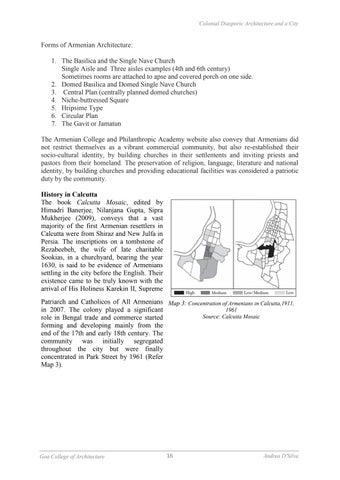`Colonial Diasporic Architecture and a City
Forms of Armenian Architecture: 1. The Basilica and the Single Nave Church Single Aisle and Three aisles examples (4th and 6th century) Sometimes rooms are attached to apse and covered porch on one side. 2. Domed Basilica and Domed Single Nave Church 3. Central Plan (centrally planned domed churches) 4. Niche-buttressed Square 5. Hripsime Type 6. Circular Plan 7. The Gavit or Jamatun The Armenian College and Philanthropic Academy website also convey that Armenians did not restrict themselves as a vibrant commercial community, but also re-established their socio-cultural identity, by building churches in their settlements and inviting priests and pastors from their homeland. The preservation of religion, language, literature and national identity, by building churches and providing educational facilities was considered a patriotic duty by the community. History in Calcutta The book Calcutta Mosaic, edited by Himadri Banerjee, Nilanjana Gupta, Sipra Mukherjee (2009), conveys that a vast majority of the first Armenian resettlers in Calcutta were from Shiraz and New Julfa in Persia. The inscriptions on a tombstone of Rezabeebeh, the wife of late charitable Sookias, in a churchyard, bearing the year 1630, is said to be evidence of Armenians settling in the city before the English. Their existence came to be truly known with the arrival of His Holiness Karekin II, Supreme Patriarch and Catholicos of All Armenians Map 3: Concentration of Armenians in Calcutta,1911, in 2007. The colony played a significant 1961 Source: Calcutta Mosaic role in Bengal trade and commerce started forming and developing mainly from the end of the 17th and early 18th century. The community was initially segregated throughout the city but were finally concentrated in Park Street by 1961 (Refer Map 3).
Goa College of Architecture
16
Andrea D'Silva



















